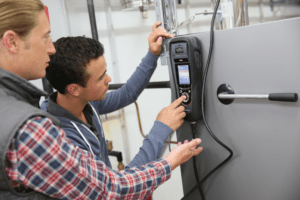Especially in smaller businesses or warmer climates, heat pumps can offer a high-value proposition. Rather than serving just one purpose, a heat pump functions as an all-in-one temperature management system for a business. It fulfills both heating and cooling applications, depending on what is necessary given the temperature in the space. Unlike an air conditioner, a furnace, or an electric space heater, heat pumps do not generate cold or hot air on their own. Instead, they work by moving heat from one location to another. During the hotter months, heat pumps extract hot air from inside your business and move it outside. During the winter, the process reverses, with the heat pump extracting heat from the outside air and pulling it inside. A heat pump installation can take multiple forms, including a split-system design (intended for heating just one office) and a ducted system design (more appropriate to full-business heating or cooling).
 Heat pumps are growing in popularity thanks to their high energy efficiency. Depending on the design of your business space, a heat pump might be the most logical (and the most cost-effective option) for interior temperature management. If you are considering a heat pump, though, follow these tips to make sure you are getting the most value possible out of your heat pump installation.
Heat pumps are growing in popularity thanks to their high energy efficiency. Depending on the design of your business space, a heat pump might be the most logical (and the most cost-effective option) for interior temperature management. If you are considering a heat pump, though, follow these tips to make sure you are getting the most value possible out of your heat pump installation.
- Keep the temperature steady
Try to minimize your temperature adjustments with the heat pump. With a typical HVAC system, we are used to adjusting the thermostat semi-regularly throughout the working day to tweak the temperature, or perhaps even programming a smart thermostat to raise or lower the system by a few degrees depending on the time of day. These tactics are smart for minimizing how long your system is running and thereby reducing your business utility bills. Heat pumps, though, have a different kind of design and always do best if allowed to sit at a stable and consistent temperature.
For instance, turning the thermostat down overnight and then back up during office hours can negate the efficiency gains that the heat pump is meant to deliver. When you turn up the heat on your heat pump too quickly, it causes a backup heater in the system to activate. This backup heater is meant for emergencies when the heat pump needs to be able to heat a space quickly. The drawback is that the backup heater is highly inefficient and expensive to operate. So, if you are inadvertently telling your system that you need quicker heating—which you do when you raise the temperature setting too quickly all at once—you are essentially turning your efficient heat pump into a far less efficient space heater.
- Experiment to get a sense of what your heat pump can do
Most of us are used to the instant results that central heating or air conditioning can provide. When you adjust the thermostat, you expect to hear the system kick on immediately, and for warm or cold air to start blasting out of your vents. With a heat pump, you aren’t going to get that same rapid result. On the contrary, when a heat pump starts heating your space, you might initially think something is wrong because the air coming out of your vents is most accurately described as lukewarm. This air is actually plenty warm enough to heat your space: it just takes a bit longer.
So, rather than jumping to any conclusions about the performance of your new heat pump installation, give it some time. Let it run for a little while without making any big adjustments to the temperature. After an hour or so, reassess and adjust the temperature up or down a degree or two. Rinse and repeat throughout the first day or so of your heat pump ownership, until you find a temperature that you find comfortable.
From this point, you can either leave the temperature setting as is on your heat pump or continue experimenting. Especially if you have a split system that is just meant to heat one area, you might be curious to learn what else it can do. By opening a few doors throughout your business, though, you might be able to spread the effects of the heat pump beyond that initial office space. Sure, the heat pump is small, but you might be surprised at what it can do.
- Never use the “Auto” mode
You may be used to using “Auto” mode on your business thermostat, but don’t do it with your heat pump. Your heat pump might get confused on colder summer days or warmer winter days. Turning the system to “Heat” in the winter and “Cool” in the summertime will eliminate the risk of a confused heat pump.
Finally, don’t forget maintenance! Like any HVAC system, your heat pump needs consistent care to ensure peak performance. Check your filters monthly for dirt, dust, or other debris, and clean or replacement them if they are looking clogged or dirty. Also, keep up with an annual calendar for inspections and maintenance by a trusted HVAC technician. These steps will help ensure that your heat pump installation continues to perform with efficiency for years to come.

